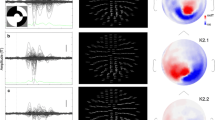Abstract
The Laplacian operator in electroencephalographic measurements consists of a mathematical combination of the responses from a number of electrodes (e.g., five in a crosswise montage). It enhances activity from sources lying underneath the area covered, relative to activity from outside this area. Thus, by appropriate positioning, the contributions of extrastriate and striate sources can be recorded selectively. To quantify the contribution of each hemisphere to half-field onset evoked potentials, the responses in two Laplacian operators, one over each hemisphere, were analyzed and compared to monopolar derivations and a bipolar derivation between the two hemispheres. Both the Laplacian and bipolar analyses were helpful in interpretation of the responses.
Similar content being viewed by others
References
Halliday AM. The visual evoked potentials in healthy subjects. In: Halliday AM, ed. Evoked potentials in clinical testing. Edinburgh: Churchill Livingstone, 1982: 71–120.
Jeffreys DA, Axford JG. Source locations of pattern-specific components of human evoked potentials. I. Components of striate cortical origin. Exp Brain Res 1972; 16: 1–21.
Jeffreys DA, Axford JG. Source locations of pattern-specific components of human evoked potentials. II. Components of extrastriate cortical origin. Exp Brain Res 1972; 16: 22–40.
Hjorth B. An online transformation of EEG scalp potentials into orthogonal source derivations. Electroencephalogr Clin Neurophysiol 1975; 39: 526–30.
Srebro R. Localization of visually evoked cortical activity in humans. J Physiol (Lond) 1985; 360: 233–46.
Srebro R. The topography of scalp potentials evoked by pattern pulse stimuli. Vision Res 1987; 27: 901–14.
Manahilov V, Riemslag FCC, Spekreijse H. The Laplacian analysis of the pattern onset response in man. Electroencephalogr Clin Neurophysiol 1992; 82: 220–224.
Kranda K, Jobert M. Spatial sources of electrophysiological activity generated by fine-pattern stimulation. In: Kulikowski JJ, Murray IJ, Dickinson CM, eds. Seeing and colour. Oxford: Pergamon Press, 1989: 485–96.
Russell MHA, Kranda K, Jobert M, Kulikowski JJ. Unipolar VEPs, Laplacean derivatives and grating detection thresholds. In: Kulikowski JJ, Murray IJ, Dickinson CM, eds. Seeing and colour. Oxford: Pergamon Press, 1989: 497–503.
De Waal BJ, Reits D, Spekreijse H, Grimbergen CA. Implementation of a portable pattern stimulator and VEP/ERG recording system based on an Apple computer. Doc Ophthalmol Proc Ser 1983; 37: 209–16.
Apkarian P, Spekreijse H, van Dorp D. A decisive electrophysiological test for human albinism. Electroencephalogr Clin Neurophysiol 1983; 55: 513–31.
Author information
Authors and Affiliations
Rights and permissions
About this article
Cite this article
Riemslag, F.C.C., Beers, A.P.A. & Spekreijse, H. The application of Laplacian analysis in the recording of half-field pattern-onset evoked potentials. Doc Ophthalmol 80, 75–82 (1992). https://doi.org/10.1007/BF00161233
Accepted:
Issue Date:
DOI: https://doi.org/10.1007/BF00161233




